(完整版)Notuntil在句首的倒装句
(完整版)Notuntil在句首的倒装句
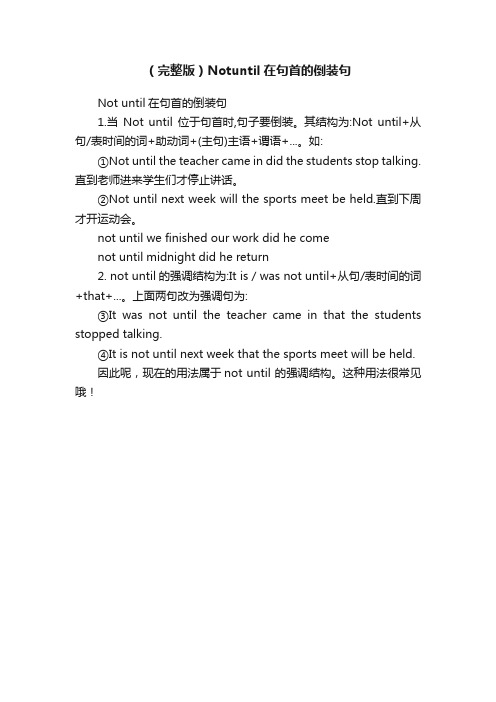
(完整版)Notuntil在句首的倒装句
Not until在句首的倒装句
1.当Not until位于句首时,句子要倒装。
其结构为:Not until+从句/表时间的词+助动词+(主句)主语+谓语+...。
如:
①Not until the teacher came in did the students stop talking.直到老师进来学生们才停止讲话。
②Not until next week will the sports meet be held.直到下周才开运动会。
not until we finished our work did he come
not until midnight did he return
2. not until的强调结构为:It is / was not until+从句/表时间的词+that+...。
上面两句改为强调句为:
③It was not until the teacher came in that the s tudents stopped talking.
④It is not until next week that the sports meet will be held.
因此呢,现在的用法属于not until 的强调结构。
这种用法很常见哦!。
not until强调句和倒装句

题目:深入理解not until强调句和倒装句一、对not until强调句和倒装句的初步理解在中文和英文句子中,为了突出某些时间或条件的重要性,我们经常会使用not until强调句和倒装句结构。
这两种结构在句子中的运用,能够让句子更加生动、丰富,同时也增加了语言的表达力。
在接下来的文章中,我将会对这两种句式进行更深入的探讨与解析,以帮助读者更好地理解和运用它们。
二、从简到繁,逐步探讨not until强调句和倒装句1. 什么是not until强调句?not until强调句是指通过将时间状语从句中的连词not until提前至句首,强调某个时间点或者条件的句式结构。
原句是"I didn't finish my homework until last night.",通过not until强调句可以改写为"Not until last night did I finish my homework."。
这种句式的使用,能够使句子更富有变化和灵活性,同时也可以使重要信息更加突出。
2. 倒装句在not until强调句中的应用在not until强调句中,倒装句的运用显得尤为重要。
倒装句是指将句子中的主语和谓语的位置调换,以强调某个时间点或条件。
在not until强调句中,倒装句的使用可以让句子更加生动,给人一种语言表达的新鲜感。
句子"I didn't realize the truth until yesterday."可以改写为"Not until yesterday did I realize the truth.",其中的倒装句结构使得句子表达更加强调切实感。
三、总结与回顾通过以上的探讨,我们可以发现not until强调句和倒装句这两种句式结构在句子表达中的重要性。
它们不仅可以丰富句子的表达方式,还可以使句子更加突出和生动。
not until倒装

not until倒装Not Until 倒装是英语语法中的一种特殊句型结构,它通常用于表示一种意外或出乎意料的情况。
本文将详细解释Not Until 倒装的用法、形式和相关注意事项,并通过提供一些例句来帮助读者更好地理解和应用该句型。
一、Not Until 倒装的用法Not Until 倒装的主要作用是在句子中强调某一具体动作的发生要在另一个动作之后。
因此,该句型常常用于表达一个事件、行为或状态在某一特定时间或条件之前没有发生或改变的情况。
通过使用Not Until 倒装,可以使句子更加生动有力,突出时间或条件的关键性。
二、Not Until 倒装的形式Not Until 倒装句的基本形式由以下几个要素构成:1. 助动词或情态动词(即be动词、have动词、do动词等);2. 主语;3. Not Until 短语;4. 其他主句部分。
具体表达形式为:助动词/情态动词 + 主语 + Not Until 短语 + 其他主句部分。
三、Not Until 倒装的示例及解析1. Not until the bell rang did the students leave the classroom.这个例句中,“Not until the bell rang”表示事件“the students leave the classroom”发生的时间要晚于“the bell rang”的时间。
在这种情况下,主语“the students”放在助动词“did”的后面,使用倒装结构来突出这种发生时间的延迟。
2. Not until I finished my homework could I go out to play.在这个例句中,“Not until I finished my homework”表示动作“go out to play”发生的时间要晚于“I finished my homework”的时间。
notuntil引起的时间状语置于句首时
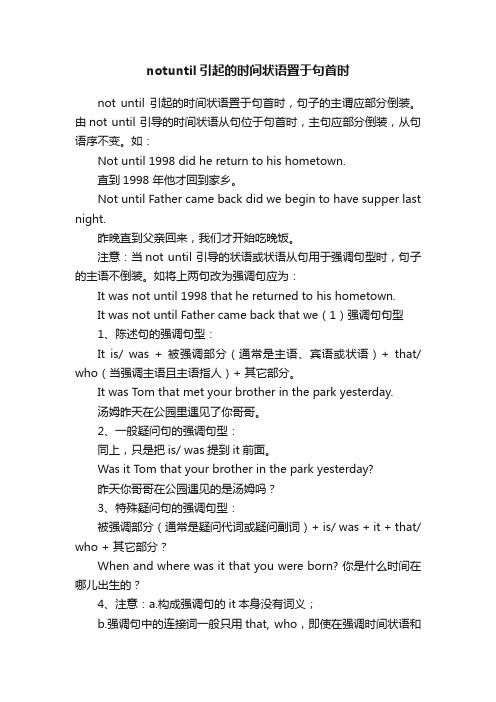
notuntil引起的时间状语置于句首时not until 引起的时间状语置于句首时,句子的主谓应部分倒装。
由not until 引导的时间状语从句位于句首时,主句应部分倒装,从句语序不变。
如:Not until 1998 did he return to his hometown.直到1998 年他才回到家乡。
Not until Father came back did we begin to have supper last night.昨晚直到父亲回来,我们才开始吃晚饭。
注意:当not until 引导的状语或状语从句用于强调句型时,句子的主语不倒装。
如将上两句改为强调句应为:It was not until 1998 that he returned to his hometown.It was not until Father came back that we(1)强调句句型1、陈述句的强调句型:It is/ was + 被强调部分(通常是主语、宾语或状语)+ that/ who(当强调主语且主语指人)+ 其它部分。
It was Tom that met your brother in the park yesterday.汤姆昨天在公园里遇见了你哥哥。
2、一般疑问句的强调句型:同上,只是把is/ was提到it前面。
Was it Tom that your brother in the park yesterday?昨天你哥哥在公园遇见的是汤姆吗?3、特殊疑问句的强调句型:被强调部分(通常是疑问代词或疑问副词)+ is/ was + it + that/ who + 其它部分?When and where was it that you were born? 你是什么时间在哪儿出生的?4、注意:a.构成强调句的it本身没有词义;b.强调句中的连接词一般只用that, who,即使在强调时间状语和地点状语时也如此,that, who不可省略;c.强调句中的时态只用两种,一般现在时和一般过去时。
not until倒装句结构
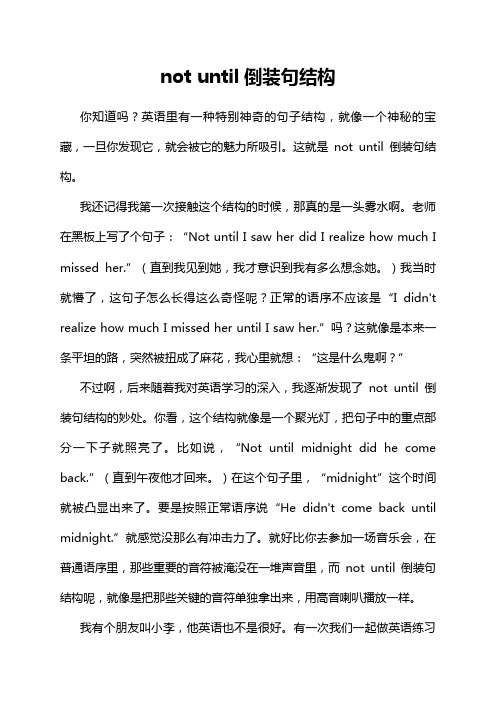
not until倒装句结构你知道吗?英语里有一种特别神奇的句子结构,就像一个神秘的宝藏,一旦你发现它,就会被它的魅力所吸引。
这就是not until倒装句结构。
我还记得我第一次接触这个结构的时候,那真的是一头雾水啊。
老师在黑板上写了个句子:“Not until I saw her did I realize how much I missed her.”(直到我见到她,我才意识到我有多么想念她。
)我当时就懵了,这句子怎么长得这么奇怪呢?正常的语序不应该是“I didn't realize how mu ch I missed her until I saw her.”吗?这就像是本来一条平坦的路,突然被扭成了麻花,我心里就想:“这是什么鬼啊?”不过啊,后来随着我对英语学习的深入,我逐渐发现了not until倒装句结构的妙处。
你看,这个结构就像是一个聚光灯,把句子中的重点部分一下子就照亮了。
比如说,“Not until midnight did he come back.”(直到午夜他才回来。
)在这个句子里,“midnight”这个时间就被凸显出来了。
要是按照正常语序说“He didn't come b ack until midnight.”就感觉没那么有冲击力了。
就好比你去参加一场音乐会,在普通语序里,那些重要的音符被淹没在一堆声音里,而not until倒装句结构呢,就像是把那些关键的音符单独拿出来,用高音喇叭播放一样。
我有个朋友叫小李,他英语也不是很好。
有一次我们一起做英语练习题,就碰到了一道关于not until倒装句结构的题。
题目是这样的:“Not until all the fish died in the river ________ how serious the pollution w as.”(直到河里所有的鱼都死了,人们才意识到污染有多严重。
)A. did the villagers realize B. the villagers realized。
not until放在句首的用法
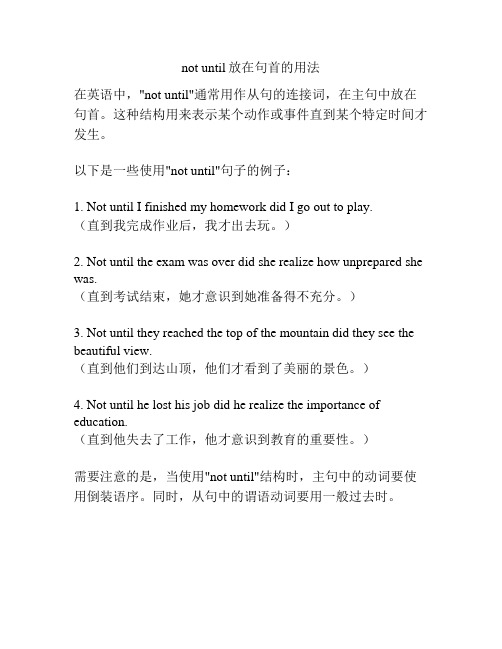
not until放在句首的用法
在英语中,"not until"通常用作从句的连接词,在主句中放在句首。
这种结构用来表示某个动作或事件直到某个特定时间才发生。
以下是一些使用"not until"句子的例子:
1. Not until I finished my homework did I go out to play.
(直到我完成作业后,我才出去玩。
)
2. Not until the exam was over did she realize how unprepared she was.
(直到考试结束,她才意识到她准备得不充分。
)
3. Not until they reached the top of the mountain did they see the beautiful view.
(直到他们到达山顶,他们才看到了美丽的景色。
)
4. Not until he lost his job did he realize the importance of education.
(直到他失去了工作,他才意识到教育的重要性。
)
需要注意的是,当使用"not until"结构时,主句中的动词要使用倒装语序。
同时,从句中的谓语动词要用一般过去时。
not until 引起的时间状语置于句首时
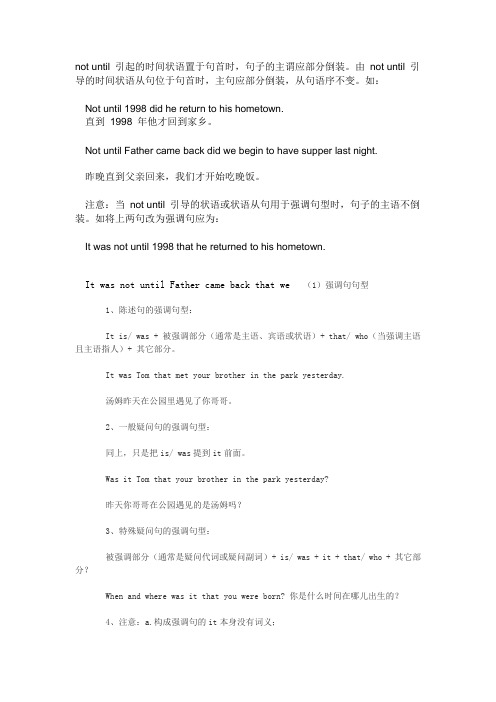
not until 引起的时间状语置于句首时,句子的主谓应部分倒装。
由not until 引导的时间状语从句位于句首时,主句应部分倒装,从句语序不变。
如:Not until 1998 did he return to his hometown.直到1998 年他才回到家乡。
Not until Father came back did we begin to have supper last night.昨晚直到父亲回来,我们才开始吃晚饭。
注意:当not until 引导的状语或状语从句用于强调句型时,句子的主语不倒装。
如将上两句改为强调句应为:It was not until 1998 that he returned to his hometown.It was not until Father came back that we(1)强调句句型1、陈述句的强调句型:It is/ was + 被强调部分(通常是主语、宾语或状语)+ that/ who(当强调主语且主语指人)+ 其它部分。
It was Tom that met your brother in the park yesterday.汤姆昨天在公园里遇见了你哥哥。
2、一般疑问句的强调句型:同上,只是把is/ was提到it前面。
Was it Tom that your brother in the park yesterday?昨天你哥哥在公园遇见的是汤姆吗?3、特殊疑问句的强调句型:被强调部分(通常是疑问代词或疑问副词)+ is/ was + it + that/ who + 其它部分?When and where was it that you were born? 你是什么时间在哪儿出生的?4、注意:a.构成强调句的it本身没有词义;b.强调句中的连接词一般只用that, who,即使在强调时间状语和地点状语时也如此,that, who不可省略;c.强调句中的时态只用两种,一般现在时和一般过去时。
not-until的倒装结构讲解学习
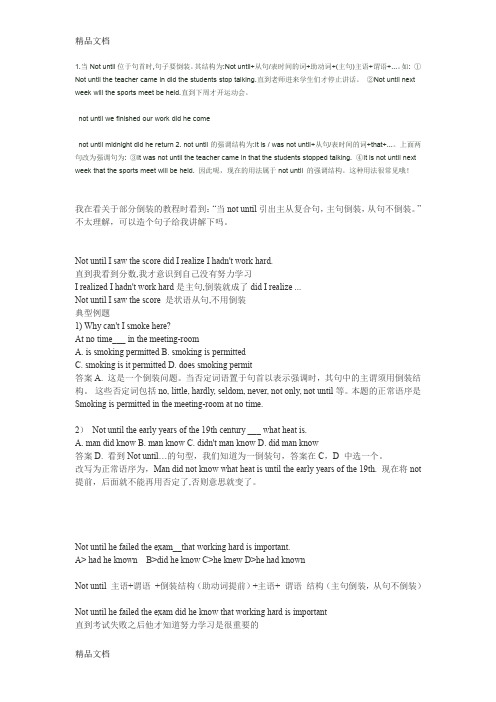
1.当Not until位于句首时,句子要倒装。
其结构为:Not until+从句/表时间的词+助动词+(主句)主语+谓语+...。
如: ①Not until the teacher came in did the students stop talking.直到老师进来学生们才停止讲话。
②Not until next week will the sports meet be held.直到下周才开运动会。
not until we finished our work did he comenot until midnight did he return 2. not until的强调结构为:It is / was not until+从句/表时间的词+that+...。
上面两句改为强调句为: ③It was not until the teacher came in that the students stopped talking. ④It is not until next week that the sports meet will be held. 因此呢,现在的用法属于not until 的强调结构。
这种用法很常见哦!我在看关于部分倒装的教程时看到:“当not until引出主从复合句,主句倒装,从句不倒装。
”不太理解,可以造个句子给我讲解下吗。
Not until I saw the score did I realize I hadn't work hard.直到我看到分数,我才意识到自己没有努力学习I realized I hadn't work hard是主句,倒装就成了did I realize ...Not until I saw the score 是状语从句,不用倒装典型例题1) Why can't I smoke here?At no time___ in the meeting-roomA. is smoking permittedB. smoking is permittedC. smoking is it permittedD. does smoking permit答案A. 这是一个倒装问题。
